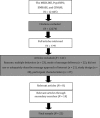A systematic review of three approaches for constructing physical activity messages: What messages work and what improvements are needed?
- PMID: 20459779
- PMCID: PMC2885311
- DOI: 10.1186/1479-5868-7-36
A systematic review of three approaches for constructing physical activity messages: What messages work and what improvements are needed?
Abstract
Background: To motivate individuals to adhere to a regular physical activity regime, guidelines must be supplemented with persuasive messages that are disseminated widely. While substantial research has examined effective strategies for disseminating physical activity messages, there has been no systematic effort to examine optimal message content. This paper reviews studies that evaluate the effectiveness of three approaches for constructing physical activity messages including tailoring messages to suit individual characteristics of message recipients (message tailoring), framing messages in terms of gains versus losses (message framing), and targeting messages to affect change in self-efficacy (i.e., a theoretical determinant of behavior change).
Methods: We searched the MEDLINE, PsycINFO, EMBASE and CINAHL databases up to July 2008. Relevant reference lists also were searched. We included intervention trials, field experiments, and laboratory-based studies that aimed to test the efficacy or effectiveness of tailored messages, framed messages and self-efficacy change messages among healthy adults. We used a descriptive approach to analyze emerging patterns in research findings. Based on this evidence we made recommendations for practice and future research.
Results: Twenty-two studies were identified. Twelve studies evaluated message tailoring. In 10 of these studies, tailored messages resulted in greater physical activity than a control message. Six studies evaluated framed messages. Five of these studies demonstrated that gain-framed messages lead to stronger intentions to be active compared to a control message. Moreover, a gain-frame advantage was evident in three of the four studies that assessed physical activity. Four studies evaluated self-efficacy change messages. The two studies that used an experimental design provide a clear indication that individuals' beliefs can be affected by messages that incorporate types of information known to be determinants of self-efficacy. Overall, strong evidence to support definitive recommendations for optimal message content and structure was lacking.
Conclusions: Additional research testing the optimal content of messages used to supplement physical activity guidelines is needed. Tailored messages, gain-framed messages, and self-efficacy change messages hold promise as strategies for constructing physical activity messages and should be a focus of future research.
Figures

Similar articles
-
Does message framing affect changes in behavioural intentions in people with psoriasis? A randomized exploratory study examining health risk communication.Psychol Health Med. 2018 Aug;23(7):763-778. doi: 10.1080/13548506.2018.1427876. Epub 2018 Jan 30. Psychol Health Med. 2018. PMID: 29380626 Clinical Trial.
-
Individual differences in drivers' cognitive processing of road safety messages.Accid Anal Prev. 2013 Jan;50:272-81. doi: 10.1016/j.aap.2012.04.018. Epub 2012 May 18. Accid Anal Prev. 2013. PMID: 22608267 Clinical Trial.
-
The effects of narrative and message framing on engagement and eating intention among a sample of adult Hispanics.J Nutr Educ Behav. 2014 Sep-Oct;46(5):396-400. doi: 10.1016/j.jneb.2013.12.005. Epub 2014 Feb 8. J Nutr Educ Behav. 2014. PMID: 24517968
-
Health message framing effects on attitudes, intentions, and behavior: a meta-analytic review.Ann Behav Med. 2012 Feb;43(1):101-16. doi: 10.1007/s12160-011-9308-7. Ann Behav Med. 2012. PMID: 21993844 Review.
-
The effects of health behaviours and beliefs based on message framing among patients with chronic diseases: a systematic review.BMJ Open. 2022 Jan 6;12(1):e055329. doi: 10.1136/bmjopen-2021-055329. BMJ Open. 2022. PMID: 34992117 Free PMC article.
Cited by
-
Physical activity preferences in a population-based sample of kidney cancer survivors.Support Care Cancer. 2012 Aug;20(8):1709-17. doi: 10.1007/s00520-011-1264-z. Epub 2011 Sep 24. Support Care Cancer. 2012. PMID: 21947412
-
Development of a Web Portal for Physical Activity and Symptom Tracking in Oncology Patients: Protocol for a Prospective Cohort Study.JMIR Res Protoc. 2018 May 15;7(5):e136. doi: 10.2196/resprot.9586. JMIR Res Protoc. 2018. PMID: 29764798 Free PMC article.
-
Gender and active travel: a qualitative data synthesis informed by machine learning.Int J Behav Nutr Phys Act. 2019 Dec 21;16(1):135. doi: 10.1186/s12966-019-0904-4. Int J Behav Nutr Phys Act. 2019. PMID: 31864372 Free PMC article.
-
Using text messages to bridge the intention-behavior gap? A pilot study on the use of text message reminders to increase objectively assessed physical activity in daily life.Front Psychol. 2012 Aug 2;3:270. doi: 10.3389/fpsyg.2012.00270. eCollection 2012. Front Psychol. 2012. PMID: 22876237 Free PMC article.
-
Message Framing and Physical Activity Promotion in Colorectal Cancer Survivors.Oncol Nurs Forum. 2016 Nov 1;43(6):697-705. doi: 10.1188/16.ONF.43-06AP. Oncol Nurs Forum. 2016. PMID: 27768135 Free PMC article.
References
-
- Brawley LR, Latimer AE. Physical activity guides for Canadians: messaging strategies, realistic expectations for change, and evaluation. J Public Health. 2007;98(Suppl 2):s170–s184. - PubMed
-
- Marshall AL, Bauman AE, Owen N, Booth ML, Crawford D, Marcus BH. Reaching out to promote physical activity in Australia: a statewide randomized controlled trial of a stage-targeted intervention. Am J Health Promot. 2004;18:283–287. - PubMed
LinkOut - more resources
Full Text Sources

